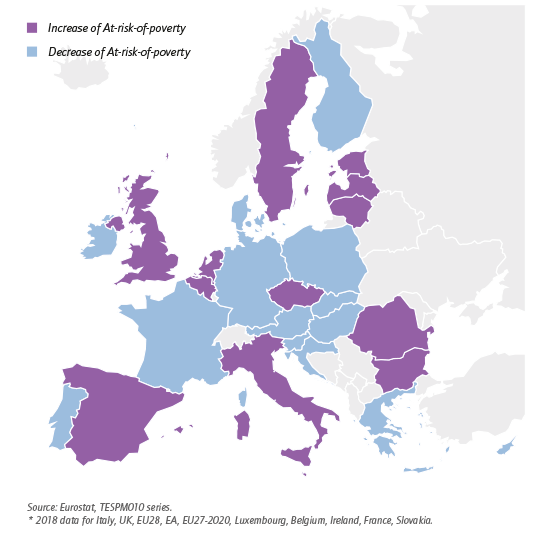Chapter Introduction
The European economies are currently in the eye of a pandemic which has been compared to that of the Spanish flu in 1918. The current pandemic hit the continent just as it had regained the lost ground from the previous crisis. At the beginning of 2020, there were signs that the pace of recovery from the previous W-shaped recession was clearly slowing down, just when the economic and social scars it had left in several member states were healing. With the new European Commission having taken office just a few months earlier and having set as one of its ambitions to make Europe the first climate-neutral continent in the world, the European Union was facing important old and new challenges ahead, with policy fronts in areas that would shape the future of Europe, such as the deepening of EMU and the implementation of the European Pillar of Social Rights, still open.
To guide the pursuit of its ambition for making Europe the first climate-neutral continent in the world, the incoming Commission launched its new growth strategy, the European Green Deal in December 2019, which, in its own words, aimed to transform the EU into a fair and prosperous society, with a modern, resource-efficient and competitive economy where economic growth was decoupled from resource use (European Commission 2019: 2). This Green Deal was also an integral part of the European Commission’s strategy to implement the United Nations’ 2030 agenda and its sustainable development goals. A little later, in January 2020, the Commission also communicated the Sustainable Europe Investment Plan, the investment pillar of the Green Deal (European Commission 2020a).
And then the pandemic happened. European policymakers and societies were caught unprepared for the magnitude and breadth of the shock Europe was about to suffer, while complacency was not in short supply even when the epidemic spread like wildfire in Lombardy, wreaking havoc to one of Europe’s hitherto best-resourced healthcare systems. The European Commission’s winter economic forecasts issued in January (European Commission 2020b) considered the downside risks from the coronavirus epidemic that was ravaging the Hubei province in China only through the channel of international trade.
The EU member states, however, were not only caught unprepared but were also affected to different degrees, rolled out different reactions based on very different capabilities to deal with such a shock. Different member states have also been facing different policy challenges prior to the pandemic, notably some member states that were emerging scarred from the previous crisis. The spread of the virus during the first wave was much faster in the west and south-west of Europe whereas it seemingly spared the east and south-east. Member states have had different healthcare system capacities, different social safety nets to deploy in supporting incomes and companies but also very different capacities to expand fiscal measures. Thus, although the pandemic did not spare any member state, the state in which it found member states, its repercussions and the responses to it could and did turn out to be quite diverse.
This chapter looks in more detail into economic developments in Europe since the beginning of the pandemic and puts them into the context of economic and social challenges that the member states were facing to different extents before its onset. It shows the different ways in which the pandemic affected European economies and it goes through the policy responses that were deployed at the national and EU level and in the shadow of lessons learnt (?) from the previous crisis. It concludes by looking into the open questions that these developments leave for the future.
A pandemic which hit in the midst of several other challenges
Even though the pandemic has so far been causing unprecedented economic damage by peacetime standards, it is not the only challenge facing Europe and its policymakers. A sustained slowdown in labour productivity growth (see chapter 2 in this volume), the depletion of natural resources and critical environmental degradation (see chapter 3 in this volume), and economic and social inequalities (see chapter 2) had been at the centre of reflections and policy debates well before the arrival of SARS-COV-19 in Europe.
Source: Own calculations using AMECO data, RVGDE and NLHA series.
Figure 1.10 shows the evolution of the average annual labour productivity growth rates in 1995-2007 and 2008-2019 for the EU and its member states (2000-2007 for the EU, Euro Area, Estonia and Malta). We see that, with the exception of Bulgaria, Malta, Denmark, Spain and Ireland, the average annual growth rates of productivity in 2008-2019 were lower than those in 1995-2007. In the case of Greece, arguably the country hardest hit by the previous economic crisis, the average annual growth rate of labour productivity was negative for the 2008-2019 period. In 15 member states, it stood at below 1% per year and this was also the case during the recovery period of 2013-2019. This is a worrying development for several reasons: labour productivity growth provides the material base for sustainably raising real wages, even if it’s not a sufficient condition for increases in real wages (see Theodoropoulou 2018b; see also chapter 4 in this volume); in principle, it makes redistribution of resources within and across generations to counter inequality politically easier; it could imply producing the same with fewer resources.
Figure 1.11b At-risk-of-poverty rate (% of population), EU Member States and the UK, 2013 and 2019* Countries with increase and decrease of AROP (map)

Figure 1.11b shows the evolution of the at-risk-of-poverty rate in the EU, member states and the UK in 2013 when the recovery period began in Europe and 2019 (2018 for the EU, Euro area, Luxembourg, Belgium, Ireland, France and Slovakia). There is a wide range of values: in 2019, almost 1 in 4 households in Romania were at risk of poverty, while only 1 in 10 households faced that risk in Czechia. There was a clear reduction in the share of households at risk of poverty in Croatia, Greece, Portugal, Poland, Ireland, Germany, Cyprus, Austria, Hungary and Slovenia. In Spain, Lithuania, the EU, the Euro area, France, and Finland the rate remained practically unchanged, whereas in Romania, Latvia, Bulgaria, Estonia, Italy, the UK, Malta, Sweden, Luxembourg, Belgium, the Netherlands and Czechia, the share of population at-risk-of-poverty increased. In other words, the long drawn out recovery between 2013 and 2019 was associated with a clearly lower risk of poverty in only 10 EU member states.
Figure 1.11 shows social protection expenditure by function (e.g. health/sickness, unemployment, old age) as a share of GDP for the EU member states for which data by Eurostat was available for 2018. Two observations stand out. First, as a total, the slice of GDP that goes into social protection functions varies from 31.5% in France to 13.7% (less than half of the figure in France) in Ireland. In principle, and insofar as social protection provides tools for supporting households against various life and market risks, this variation shows the different degrees to which member states are equipped for facing a crisis such as the current pandemic. Secondly, it illustrates the different relative weight that expenses dedicated to old age, unemployment and family bear in different countries and thereby the different ways in which they operationalize resilience.

